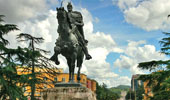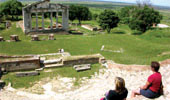Day 1. Kruje - Tirane
Arrival at the Airport and transfer to Kruja
Kruja

Having survived for thousands of years, nearly disappeared at the beginning of the 20th Century and been brought back to life during the last 50 years, Kruja is a tourist attraction alongside a panoramic mountainside location. “Kruja is a strange town, all clustered around its bazaar.” Some of the main points of interests include the restored Castle and Citadel that it is tied to the legend of the hero who fought against the Turks for about 25 years. The Skanderbeg Museum located inside the castle and erected in memory of the Albanian national hero. Skanderbeg was in fact from these parts and Kruja was a strategic point in the anti-Ottoman resistance. The Old Restored Bazaar has a truly oriental look, multi-colored and overflowing with goods of every description. The citadel includes the restored house of the Pasha of Kruja, dating from the ottoman period, which hosts the Ethnographic Museum. Leave to Tirana.
Day 2. Tirana – Berat – Apollonia - Tirana
After breakfast drive to Berat. Arrival in Berat.The tour of the city will include the lower quarters and the upper fortress passing by ottoman laic architectures, byzantine churches and elegant mosques.
Berat

Berat is also known as “The town of a Thousand windows” due to the many large buildings that decorate the houses of the old town. The town is still renowned for its historic architecture and particular beauty and is declared as a world heritage site by UNESCO. Historical Berat consist of three quarters. The quarters of Gorica and Mangalem are situated on the slopes of two hills that are divided by the river Osum. The Kalaja (fortress) quarter stands on the top of the Magalemi hill and is enclosed by a fortification wall that dates back to the IV century BC. The town has several XV century mosques, very well decorated and a very large numbers of Byzantine orthodox churches. Several of the churches has frescoes by the well known painter Onufri and his school and from other later famous schools of frescos and icons of the Balkan area. Of particular interest are: The icons museum located in the old cathedral church of the Castle and the Ethnographic museum hosted in an old house in the Mangalem quarter.
Lunch in a traditional restaurant. Drive toward Apollonia.
Arrival and walking tour of the park of Apolonia.
The ancient city of Apollonia of Illyria was founded at the beginning of the VII century BC. by Greek colons coming by the cities of Corinth and Corcyra. Apollonia became an emporium of merchandising between Greeks an Illyrians and was taken by Aristotle as a model in his analysis of oligarchy due to the distinct and separate Greek and Illyrian communities. The city prospered very much in roman times. It was a vital stronghold in Caesar’s civil war with Pompey and also important in early Christian history as the resident bishop attended the councils of Ephesus and Chalkis in 431 and 451. The discovered monuments on the site are: the fortification wall of the city, the Prytaneon, the Bouleterion, the big and small Stoas, the Odeion, the Theatre, the Nympheum and many more. The museum of Apollonia is hosted in the nearby monastery of the XIV century where can be visited also the Church of St. Mary.
Day 3. Tirana – Out
Sightseeing tour of the city concentrated on Tirana Highlights.
Tirana

A cross between Istanbul and Naples with a pinch of Minsk. The capital and the biggest city in Albania offer a wide range of activities, museums and monuments to explore. In the main square of the city, Skanderbeg Square, and along the main “boulevard” named “The Martyrs of the Nations” are located most of the Museums buildings and monuments of Tirana. In the main square are located: The National Historic Museum with its façade decorated by a large mosaic called “Albania”, the huge statue of Skanderbeg, the Et’hem beg mosque with its delicious decorations, the Palace of Culture, where the Theatre of Opera and Ballet and National Library are located, the government buildings that close the square from the south side. Instead along the main “boulevard” and not far from it can be seen: The Catholic church of St. Paul completed in 2001, The Orthodox Cathedral, The late medieval bridge of Tabakeve, the remains of the old fortress of Tirana, different houses in ottoman style. The building of the Parliament, the academy of Sciences building, the Gallery of Figurative Arts, The International Cultural Centre, constructed in 1988 to be the Museum of the ex communist dictator Enver Hoxha and commonly called by the people “The pyramid” according to the strange and curious pyramidal shape of the building, the Palace of the Congresses and the Presidential Residence. The monument of Mother Albania, 12 meters high, was inaugurated in the “Heroes of the Nation” cemetery in 1971.
Visit the Et’hem Beg Mosque and the National Museum.
Departure to Airport – flight










